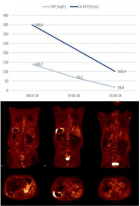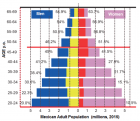Early Online (Volume - 7 | Issue - 2)
Design and Construction of Automatic Facemask and Body Temperature Scanning Entry Barrier Machine
Published on: 10th July, 2024
In the context of the global pandemic, public health screening has become paramount as the whole world including developed countries is going through a health crisis. A face mask prevents transpiration and protects against airborne transmitted bacteria or viruses. In the previous scenario of coronavirus, it was critical to eradicate this sickness and preserve our lives. Hence, prevention is better than cure becomes true. Accordingly, many precautionary measures were taken to reduce the spread of the virus. One such method of prevention is wearing a mask and regular monitoring of body temperature. This research dealt with the design and construction of an automatic entry barrier machine that integrates both facemask detection and scanning of individuals exhibiting elevated body temperature functionalities without any human interference. This was accomplished by simulating and synergizing a microprocessor (Raspberry Pi 3 Model B+), a Pi camera, an Infrared Non-contact Temperature sensor, a servo motor, and other components. The barrier arm opens and allows entrance at normal temperature by indicating a green light, displaying ‘allow’ on the LCD, and signaling once or preventing entrance at an elevated unacceptable temperature by indicating a red light, displaying ‘not allowed’ on the LCD, and signaling five (5) times.
Mechanistic Insights into UV Spectral Changes of Pyruvic Acid and Pyruvate Part 1: Interaction with Water Molecules
Published on: 16th July, 2024
We investigate how the UV spectra of pyruvic acid (PA) and pyruvate are impacted by interactions with water molecules. In particular, we would like to understand the mechanistic origin of the blue shift in the n →− π∗ transition. Pyruvic acid is the simplest α-keto organic acid and is common in the environment. We use density functional theory to optimize geometries to determine excitation energies and find that the excitation energies of the two main pyruvic acid conformers and pyruvate blue shift when interacting with 1 to 4 water molecules, both in vacuo and in a solvent. The excitation wavelength is blue-shifted by 0.9-9.2 nm when adding water molecules to the lowest energy conformer of PA. Calculations of the UV spectra of pyruvic acid (PA) and pyruvate are crucial for understanding the impact of the interactions with water molecules.
West Africa's Drought Dynamics: An Investigation of SPI and SPEI indices (1979-2021)
Published on: 24th July, 2024
West Africa’s population is projected to reach 500 million by 2050, exacerbating the need for reliable drought detection and management strategies to ensure food and water security. This study investigated drought detection in West Africa using the Standardized Precipitation Index (SPI) and Standardized Precipitation Evapotranspiration Index (SPEI). The objective is to evaluate the performance of SPI and SPEI in detecting droughts and compare their strengths and limitations. The results revealed that both indices detected droughts effectively, but SPEI was more sensitive to evapotranspiration and temperature change. The findings offer valuable insights into climate change impacts, drought monitoring, and sustainable water resource management in the regions under investigation in West Africa.
Catalytic Oxidation-like Nuclear Nano-fusion; Fractal Involving of Room Temperature Magnetically Induced μ-Catalyzed Fusion
Published on: 24th July, 2024
The nuclear fusion reaction can be catalyzed in a suitable fusion fuel by muons (heavy electrons). “For the fractal relations, ranging from DNA knots to solar neutrino flux signals”, ever derived of scale-invariant properties distinguished between classical invariant theory & quantum invariant theory subfactors. Accompanying isomorphic & Connes FusionTensor Product retrieved to μ-catalyzed fusion where surroundings of room temperature fusion driven by the balance in mtDNA fusion & fission. On behalf of the nanometer dimension of the radius of heavy electrons & wavelength of UV-light, it assumed that muons can be produced by oxidation-like decay when UV-light impinging water.
Nonlinear Numbers to Public Debt Growth through Mathematical Induction
Published on: 2nd August, 2024
Just as an individual is expected to control his/her debt-to-asset ratio, so is a government expected to control its national debt as a function of the country’s wealth, measured e.g. by its gross domestic product/GDP [1].
Generalized Trace Inequalities for Q Uncertainty Relations
Published on: 20th August, 2024
Iin 2015 we obtained non-hermitian extensions of Heisenberg type and Schrödinger type uncertainty relations for generalized metric adjusted skew information or generalized metric adjusted correlation measure and gave the results of Dou-Du in 2013 and 2014 as corollaries. In this paper, we define generalized quasi-metric adjusted Q skew information for different two generalized states and obtain corresponding uncertainty relation. The result is applied to the inequalities related to fidelity and trace distance for different two generalized states which were given by Audenaert, et al. in 2009 and 2008; and Powers-Strmer in 1970. 2010 Mathematics Subject Classification: 15A45, 47A63, 94A17.
Simulation and Analysis of Photonic Bandgapsin 1D Photonic Crystals Using MEEP
Published on: 23rd August, 2024
This study presents a comprehensive simulation and analysis of photonic band gaps in one-dimensional (1D) photonic crystals using the open-source software MEEP. Photonic crystals, with their periodic structures, exhibit photonic bandgaps that prevent the propagation of specific wavelengths of light, making them crucial for various optical applications. Unlike previous studies that primarily focused on theoretical and experimental methods, this research introduces a novel computational approach that enhances the accuracy and flexibility of modeling these bandgaps. Through detailed simulations, we explore the impact of different structural parameters on the photonic bandgap properties, providing valuable insights into optimizing these crystals for practical use. Our findings demonstrate significant improvements in the design and understanding of 1D photonic crystals, particularly in tailoring bandgaps for specific applications in optical devices. This work contributes to the advancement of photonic crystal technology by offering a robust framework for their analysis and application.
Additional Gold Recovery from Tailing Waste By Ion Exchange Resins
Published on: 30th August, 2024
The article describes the gamma activation analysis method used to determine the gold content in rock samples using the Aura measuring complex. The physicochemical basis of gold extraction in the process of cyanide leaching is considered. The technology for extracting gold from solutions of tailing waste “ponds” of tailings dumps of hydrometallurgical plants of the Joint Stock Company “Navoi Mining and Metallurgical Combine” (JSC NMMC) is presented. It has been shown that in the dynamic mode of sorption of tailing waste solutions acidified to pH = 3.3÷3.5 through AM-2B and VP-1P ion exchange resins, gold is sorbed on the AM-2B anion exchanger up to 3.9 mg/g and on the VP-1P anion exchanger up to 1.5 mg/g. It has been shown that when solutions of tailing waste are exposed to ammonia, ammonia complex compounds of base metal impurities are formed, which decompose, while the gold cyanide complex does not decompose and is sorbed on the AM-2B ion exchange resin up to 3.0 mg/g. The mechanisms of the chemical reactions of the process of extracting gold from tailing waste and the technological scheme of the installation for extracting gold from solutions of the tailing waste “pond” are presented.
Comparison of Rhodium, Vanadium, Cobalt, Inconel & Silver Emitter Self-Powered Neutron Detectors: Literature Review Article
Published on: 7th October, 2024
Self-Powered Neutron Detectors (SPNDs) are in use as in-core Neutron Fluence Detectors in Nuclear Power Plants. Though the detectors are simple in design and have a common structure for the same application, there are various types of emitters (neutron-sensitive electrodes) that make SPNDs categorized into different types. There are various SPNDs in application at different types of nuclear power reactors. SPND emitters are chosen based on their characteristics/behavior in the neutron & gamma flux environment in the reactor core. A detailed Literature Review was done on five different types of SPNDs. This paper focuses on the physics behind the operation, characteristics, and review of Vanadium, Rhodium, Inconel, and Cobalt & Silver emitter-based SPNDs. A comparison study was done by a literature review on these detectors.
Precessional Motion Emerging from Relativistic Component of External Force
Published on: 25th October, 2024
The external force in the relativistic equation of motion can be separated into two components: Fr and Fp. The first is expressed by the physical force divided by the square of the relativistic Lorentz factor, i.e γ2. This force dominates for non-relativistic velocities and vanishes for velocities approaching the speed of light c. On the other hand, the second term increases from zero with increasing velocity and dominates for velocities close to c. It is then a purely relativistic component. The characteristic feature of this component is its zero power, Fp ⋅ v = 0, but it is responsible for the relativistic precession. The effect was confirmed by numerical solutions of the equation of motion. Relativistic formulas for the precession frequency for point objects moving in selected fields of central forces were also derived analytically. It has been shown that for weak gravitational interactions, the correction for relativistic precession is small, negligibly small for Earth, and relatively small, though measurable, for Mercury. In turn, for the microworld and electrostatic forces (e.g., for the hydrogen atom), relativistic precession can fundamentally affect the movement of the electron.
Various Theories of Fast and Ultrafast Magnetization Dynamics
Published on: 21st November, 2024
The background of my paper is that magnetization dynamics is a very important subject of basic and technological research. The purpose of the paper is to review various theories of magnetization dynamics. There are many important technological applications of magnetization dynamics.
Cyclical Cosmology, Energy and Curvature of Space-Time
Published on: 28th November, 2024
Cyclical cosmic conditions illuminate profound philosophical and physical implications regarding the fundamental nature of the universe. From this perspective, a singularity could actually symbolize a transformation of the underlying structures and laws of our universe, providing insights into the relationships among energy, curvature, and existence of the universe itself. In cyclical cosmology, the universe can be understood as existing in two distinct states: a static potential state and an active kinetic state. Quantum mechanics also reinforces the belief that even in seemingly empty spaces, vacuum fluctuations and differences in potential can give rise to emergent phenomena.
String Theory without Extra Dimensions and Without Supersymmetry
Published on: 29th November, 2024
We know that until today no experiment observation has shown the existence of Supersymmetric particles [1] or additional dimensions.

HSPI: We're glad you're here. Please click "create a new Query" if you are a new visitor to our website and need further information from us.
If you are already a member of our network and need to keep track of any developments regarding a question you have already submitted, click "take me to my Query."

























































































































































